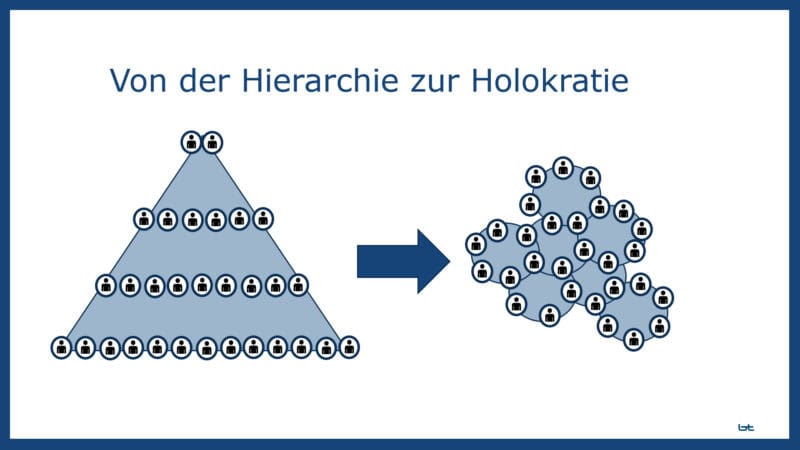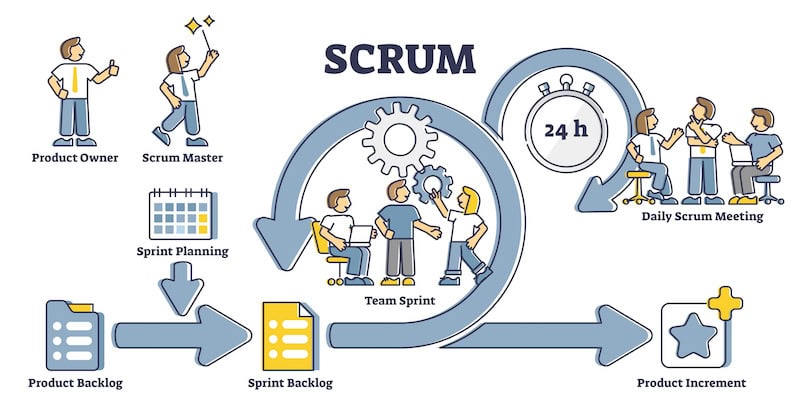Self-organization in the company: What is it? How does it work?
What is self-organization? What is it good for? How can you initiate them in your company?
Questions about self-organization:
Self-organization, agility and flat hierarchies are currently being discussed everywhere. Naturally, this raises questions: It sounds super modern to have a self-organized, agile company, but what should it look like in practice? If managers are simply abolished and everyone does what they want, will anyone do anything at all? And if so, is it the right thing to do? If nobody specifies anything, doesn’t that create a huge amount of chaos?
Is self-organization really the solution to all problems? Are there areas where they should be used and others where they should not? What are the benefits at the end of the day; is self-organization worthwhile?
We are stepping up to explain all of this.

Who does self-organization suit?
Christine, 33, works in a start-up that has been on the market for about 5 years. The company operates a web-based platform that brings together customers and suppliers in a specific market. At 43, boss Sven is the oldest member of the tribe: most of the people in the company are in their twenties. He is an icon for the young and dynamic team.
Christine is originally a web designer. Now she is the go-to girl for everything and supports founder Sven with everything that comes up.
The company is successful. It grows and grows. Sven has worked a lot and earned a lot of money. He still has a lot riding on him, he has to make decisions all the time. He would like to pull himself out a little and enjoy his success. At some point, the stressful start-up phase has to be over. So how do you delegate?
More hierarchy or less?
The plan is to have the growing team managed by team leaders in future, i.e. to add a hierarchical level. There are some in the company who are keen on team leadership positions. Christine also has her sights set on such a position. But there’s something wrong with this idea.
“I’m no better or smarter than the others. Why should I suddenly have to guide and control them? That feels kind of weird!”
Christine worked in a similar situation in another company when she was younger. As the company grew and team leaders were introduced, the original dynamic was lost: suddenly there were areas of responsibility that were adhered to as far as possible; even unimportant decisions were always passed upwards. The drive in the team was lost.
Over sushi lunch with Sven, she openly discusses her concerns. Sven calms down, nods and says thoughtfully that he never really wanted a traditional, hierarchical company. In addition, the team is so young and it would not fit into the very relaxed corporate culture. Sven says that he is definitely ready to implement a better idea, but he doesn’t have one at the moment.
All about self-organization
Christine is given the task of going on a search. She wonders:
How can a company be organized with as few hierarchies as possible? What options are there for self-organization? How do I promote self-organization? And what are the pitfalls?

Self-organization – what is it?
Definition of self-organization
Self-organization means that a team takes on tasks that would otherwise only be the responsibility of its manager: Employees manage themselves, structure their day-to-day work, bear responsibility and have a high degree of decision-making freedom. Hierarchies fall away.
Self-organization is a form of organization in which management tasks are integrated into the team. Entire companies or just individual teams or projects can work in self-organization.
Why does a company need self-organization?
There are several reasons why companies introduce self-organization. Ultimately, as with all interventions, the aim is to make the organization more successful. So what makes a company successful?
The two most important factors critical to success today are
- motivated employees
- and their ability to react quickly to changing circumstances.
We want to go into this in more detail here.
Motivation
We all know that. The classic: you’re in the DIY store and don’t know exactly which screws you need for your wall. So you look around for help, but whenever you see employees, they disappear again. Then you discover three employees engrossed in conversation between the shelves. You politely wait for the end of the collegial exchange, which is not in sight. To stop people ignoring you, you shyly ask for advice on screws. And then employee Müller drags himself in your direction, sighing and rolling his eyes, and informs you that you actually have to wait at the information desk. You realize: you are disturbing. The interest in selling something seems to be comparatively low among colleagues.
Unfortunately, this is not an isolated case. Regardless of the industry, we encounter unmotivated employees everywhere. There are many, very many. To be precise: it is the majority! No joke.

The Engagement Index
And this has even been scientifically proven: For 21 years, Gallup has been publishing studies that make statements about how committed and motivated employees are and how emotionally attached they are to their company: the annual Gallup Engagement Index. The results are alarming:
According to the Gallup Engagement Index 2021, only 17% of employees are emotionally connected to their employer. 69% have a low commitment and drag themselves through with minimal effort. 14% do not feel emotionally connected at all, they have resigned internally. Gallup estimates the costs due to internal dismissal in 2021 at 93 to 115.1 billion euros.
Because internal dismissal means: not even working to rule. See DIY store service employee Müller…
One thing is clear: unmotivated employees are no guarantee for a successful company. The opposite is the case: the company can only secure long-term success if employees think and act in the interests of the company.
Leadership factor
The figures are tough: 86% do not feel connected to their company. Why is that?
Marco Nink, responsible for the Engagement Index at Gallup: “When it comes to emotional commitment, it is not so much the salary that plays a decisive role, but above all a good manager”, as this was expressed by disgruntled employees in many Gallup surveys worldwide.
Our experience: Good leadership is the exception rather than the rule. Managers take too little time for leadership or hinder employees by restricting their scope of action or the typical bottleneck in decision-making. This is where self-organization comes into play: If employees have more freedom, more decision-making and design options, then they identify more with the task and enjoy their work more. And of course, an activity that you like is done better and more comprehensively than an unpleasant duty. However, it is important that all management tasks are carried out within the team.

Fast responsiveness
We have written about this many times before. But even if we hadn’t, everyone probably realizes that our world is becoming faster and more complex every day.
There is a term that summarizes this phenomenon. It is the acronym VUCA.
This stands for
- V erability,
- U ncertainty,
- C omplexity and
- A mbiguity/ambiguity.
In short, we live in a world that is neither predictable nor easy to understand. This means that unpredictable changes (in the market, environment, technologies and so on) increasingly mean that long-term strategies do not work because the fundamentals have changed in the meantime.
Even instructions that are handed down from the top of the company to the employees may be obsolete by the time they arrive, because the employees are now confronted with a completely different situation. So who can make the best decisions in the face of rapidly changing conditions? A manager far removed from the day-to-day business or employees who work with customers, who sit at the base and see what happens?
One example:
In our digital world, customers expect quick answers, often within just one hour. It is advisable to give employees as much freedom as possible to make decisions so that they can react in good time. If the decision had to be passed through several hierarchical levels first, it would not be possible to meet the customer’s needs. This is where the theory of self-organization comes into play, which assumes that the more decentralized an organization is, the faster it can react.
The advantages for a company are obvious: motivated employees and the ability to act quickly. There is also another ideological impulse:
In this day and age, shouldn’t we be asking ourselves whether hierarchies are perhaps totally outdated?

Commitment as the key to success
Christine reflects: in her company, the employees think for themselves. And they are fast too. All in all, the company is a lively, mostly good-humored bunch of young people who feel comfortable with each other and are motivated to come to work. This is what has made the company so successful.
However, she didn’t realize until now that this could be one of the keys to success.
Our video on the topic of self-organization
In the Vuca world, it’s all about reacting faster and more flexibly to customers and the market. One prerequisite for this is that each employee can make decisions as independently as possible and that teams organize themselves. But how can this work? And do you still need managers? What are the advantages and disadvantages of self-organization for the company? In this interview, Susanne answers these and other hotly debated questions.
Time-Stamps 4:02 min
0:00 Intro
0:26 What is self-organization?
0:41 Story
1:18 It needs someone to take the initiative
1:40 How to lead with self-organization?
2:11 Leadership roles without hierarchy
2:57 Why is it useful?
3:50 Outro
Why doesn’t everyone practice self-organization?
Christine wonders why this classic way of leadership exists at all. If self-organization is so successful, why doesn’t everyone just do it? Why are so many companies organized in a straight hierarchy?
From micromanagement to self-organization
Let’s take a look at how the history of leadership has developed:
In the 19th century, the American Frederick Winslow Taylor (1856-1915) developed scientific management, also known today as Taylorism. In very simplified terms, this is about the division of labor between workers and management: the management specifies what is to be done, and the worker does the same.
How did this come about?
Taylor was concerned with how a company can produce most efficiently. To this end, he analyzed all work processes. He observed in factories that workers lost a lot of time doing work that was not directly in their area of expertise, such as sharpening their tools or collecting the items they needed. Valuable working time was lost. He broke down the production process into individual work steps. The workers were now entrusted with just one single work step, which was specified in detail, instead of having to think through and work through the entire process as before. This laid the foundation for assembly line work. At the time, this was a completely revolutionary way of thinking.
Taylor’s understanding of leadership
It soon became clear that Taylor’s concept worked: The production process accelerated many times over if each person only carried out one work step and mastered it extremely routinely and in quick succession. Taylor’s credo was: “A worker does not have to think or even understand the whole process.” According to Taylor, this was the task of management. The worker simply had to be able to carry out his task as well and efficiently as possible.

The successes of Taylorism
Taylor achieved a performance increase of up to 370% with his method. The workers received 60% higher wages and were initially satisfied with this. A jolt went through the industry, many were enthusiastic about the new way of thinking, the increased efficiency and the higher profits.
Ford used this method to produce cheap cars for the masses and the production of mass-produced goods, which could be offered more cheaply thanks to efficient production, also began in other areas. Progress had arrived.
The dark side of Taylorism
But Taylor’s division of labor also had its downside: it alienated employees from their work. And this went hand in hand with the issue of control: because if you only carry out small parts of the work in a disjointed manner in eternal repetition, you won’t enjoy what you do. And if you don’t enjoy your work, you naturally try to avoid the unpleasant activity and do as little of it as possible. As a result, the checks became more and more stringent to ensure that the workers were doing their job.
This gave rise to the hierarchical management structure that we still have today.
Leadership today
But times have changed. Nowadays, most tasks require employees to use their heads and keep an eye on the big picture. If employees do not think for themselves, but instead blindly follow individual instructions, the company runs the risk of failing to complete the tasks. In addition, separating decision-making and implementation makes the company slow and inflexible.
For these reasons, organizations are increasingly focusing on agility and self-organization; on enabling their employees to act independently in the interests of the company.

Holocracy? What is that?
In connection with leadership, Christine stumbled across the term holacracy. This has something to do with self-organization. But what exactly? What is holacracy? Is this a method of self-organization?
Self-organization methods
What is holacracy?
Definition of holacracy
Holacracy is a form of organizational structure that focuses on reducing hierarchies. It was developed by Brian Robertson on the basis of sociocracy. Instead of structuring teams with team leaders or departments with department heads, roles and circles are formed in holacracy with the aim of distributing management tasks in the circles in a self-organized manner.
What is sociocracy?
Definition of sociocracy
As I said, holocracy is based on sociocracy. Sociocracy means that all people in the company are of equal value. Decisions are made jointly. Four principles apply here: Consensus (how decisions are made), the circle structure, linking the circles and open election of functionaries.
What is consensus?
Consensus is a form of team decision-making that ensures that things move forward. Proposals are briefly discussed. Objections are heard and incorporated into the idea. And if a proposal is not vetoed, it will be implemented, i.e. at least tried out until the next vote. The fact that there is no need for an active majority and certainly no consensus means that more change is permitted and it also happens faster.
Self-organization as we discuss it here uses elements of holocracy and sociocracy. We will go into the other topics below.
Can leadership work without a boss?
“Sounds exciting,” thinks Christine, but she still has a lot of questions: if Sven withdraws and is not available as a last resort because he might be crossing the Pacific in a sailing boat, how will the business run? Of course, everyone already has a lot of freedom. But for many, many things, Sven is always asked in the final instance.
What is important for self-organization?
When people talk about self-organization, they often paint the horror scenario that nothing will work without managers. Is that true?
Yes and no.
Simply not saying anything at all or saying something along the lines of “Right, now do it!” will indeed cause great confusion. There are studies on this: when the management suddenly fails completely, teams are usually thunderstruck and don’t know what to do. They are irritated, processes become chaotic and output is significantly lower.
So how do you act when nobody says what to do, when, how and nobody checks whether it has been done?
– Prepare!
Management tasks
There are management tasks that make sense and that have to be done. But: It is not said that these management tasks must be assumed by a manager. This can be done by people in the team. It is important that these management tasks are clearly defined and known to everyone. And, of course, that there are rules about who takes them on and when.
It is desirable that the people who take on the management tasks take turns. Because if the same person always takes on the management tasks, this could create an unofficial hierarchy.
Open election
This is why the principle of open elections exists:
The people who are to take on roles and tasks are selected by consensus in a moderated process following an open exchange.
Framework conditions for self-organization
What is needed is a clear structure. Everyone should know what is regulated and how. The basis is precise planning of roles and responsibilities so that everyone always knows what needs to be done and what is pending.
Can anyone really lead?
Does the management alternate? Hmm, sounds nice, but how is that supposed to work? How is Mo, 22, a programmer in a T-shirt that is far too big, supposed to suddenly become a manager? Without training, experience and then only for one day at a time? Christine remains critical: isn’t it dangerous to put the weal and woe of the company in the hands of young rookies?
How does self-organization work? The 9 basics
The following 9 tips will show you what you need to do to make self-organization work.
1. self-organization? Yes, but doesn’t that create total chaos?
The structure
How do you design the organization in self-organization?
Our diagram shows it: in a traditional company, there is top-down management in the form of an organizational pyramid. The company management sets the tone from the top; execution takes place at the bottom.
In a self-organized company, organization takes place in circles instead of hierarchies. In order to plan or make decisions, the members of the individual teams come together and then decide together. This means that the decision is not made by a single person, but is based on the knowledge gathered by many people. There are several circles on different topics.
The strategy group
Yes, there is a circle in which the threads come together. The Strategy Circle is the organization’s highest decision-making body. This is where the direction is set and fundamental issues are decided. People from the individual areas or teams should be represented in this group. It doesn’t always have to be the same people who represent a team. These representatives contribute information from the respective team to the strategic circle. Of course, there are also representatives who bring information about the company’s direction and fundamental decisions to the team.

Which circles make sense?
Circles can of course be formed from the existing teams. However, it often makes sense to set up multifunctional teams or circles. People from a wide variety of former departments come together here. This type of circle is usually customer-oriented or project-oriented. It is perfectly possible and sensible to form teams that only work together for a limited period of time, such as four weeks. Each employee can be part of several circles at the same time.
Communication between the circles
Representatives of the teams ensure the exchange of information between the operational and strategic levels, as well as with neighboring groups.
The representatives
Representatives are responsible for introducing and gathering information in other circles. It can be useful to separate these two functions: One person represents their own team in another circle, the other contributes information from another circle to the team. Ultimately, the aim is to avoid creating a position of power and thus a hierarchy through information advantage. This is also counteracted by having to fill the deputy position again after a fixed period, for example a month or a quarter.

Which part of the company is self-organized?
The structure also includes considering which part of the company should work in self-organization. In principle, anything is possible: the illustration above shows a company that is completely self-organized,
works holocratically. In other companies, only certain departments are self-organized. Individual projects can be self-organized. Also possible: a classically managed department only handles certain tasks in a self-organized manner; for example, the duty roster or vacation plan. It is important to clarify in advance exactly what is to be worked on in self-organization and what is not.
Who will prevail?
Christine sees land in sight. So programmer Mo doesn’t have to become the pop-up boss. Reassuring. There is no question that the IT geeks Mo belongs to do a good job. And yes, it could certainly be much easier if the IT people came together in a team and only one person explained the complex interrelationships at a time, instead of everyone asking similar questions and giving similar explanations to various other employees as before. – And in the end, Sven has to deal with it again. Sometimes several times.
But should Mo and the geeks really be making important decisions? The IT perspective does not always coincide with the perspectives of marketing, sales or finance. Who weighs up which perspective carries more weight?

2. self-organization? Yes, but: If the boss no longer decides – who does?
Decisions
Conflicting decisions
In the company of one of our customers, there was an area with four departments. A separate self-organized team was set up in which people from the four departments took part. This self-organized team was to tackle innovations and process improvements that would advance the entire division. Decisions should be made here.
And so conflicts arose: the division and the departments continued to be managed classically. The innovation team’s decisions were undermined by departmental managers and the division manager. A tussle of competence arose.
Decisions in self-organization: Who gets to decide?
Even if the entire company works in self-organization and decisions cannot collide with classically organized parts of the company, it must be clarified who can decide what and how: some things are decided in circles, others are decided by the employees on their own responsibility because it is about their competence, their tasks. Some decisions require a consensus, while a simple majority is sufficient for others.
Also possible: The task determines how the team organizes itself, who takes on which role and which activity. This can change from project to project. Clarity is needed to enable people to act independently, make decisions and act on their own responsibility:
- Who is responsible for what?
- Who can make which decisions?
- How far does the individual’s decision-making authority extend?
- Where does the dual control principle apply?
- When does the team start making decisions?
- How do you make decisions?

How to decide without a boss?
Up to this point, Christine is on board. Of course, everyone needs to know what they are responsible for and what they can decide. But if the company sets sail in a self-organized manner and boss Sven no longer navigates all kinds of questions, on what basis should the motivated but inexperienced employees make decisions? How can it be ensured that Sven sips cocktails undisturbed in the tropics and that the crew at home doesn’t run aground without the captain, who knows all the tricks of the trade? What should they use as a guide when the waves are high?
How is the decision made? Basis for decision-making in self-organization
Clear guidelines are needed to ensure that decisions are not made in a criss-cross fashion. And these should be based on the company’s orientation and strategic decisions. These are, for example: the company vision, values, guidelines, principles that regulate, for example, which product or which market to focus on, how goodwill is handled, how to deal with each other and so on.
These guidelines are comparable to crash barriers on the highway. On the highway, you know where it leads, you know the rules, you know what you can and can’t do. The crash barriers show where the lane is and where the field begins, and the lanes provide different options for driving. If I know that I have to be in Hamburg at 2 p.m., then I can decide when to set off, take a break or not, chase after a truck or set new records in the fast lane.
I just have to comply with the regulations: Hamburg, 14:00 and the StVO.
How to prepare decision-making competence?
Ask yourself: what do we need to establish so that people in our self-organization are well oriented and can organize? What are the goals we want to achieve? What works, what doesn’t? Of course, the questions differ depending on the content of the company. The strategic circle is responsible for these guidelines. If you need support – you know where to find us…
Who leads?
“Ok, that would already help me enormously with many decisions,” says Christine. “With such guidelines, I could indeed make much more relaxed decisions and wouldn’t always need Sven’s blessing.”
Christine’s interest picks up speed: “What about all the other things Sven has to deal with? Who does that then?”

3.
Self-organization? Yes, but: Who leads without managers?
Management tasks in the self-organization
Even if leadership in the hierarchical sense is abolished, the tasks that leadership has always performed – and which must continue to be performed – remain.
These include, for example, setting the company’s direction, defining performance parameters, cost efficiency, keeping an eye on added value for customers, creating structures within the company, assigning decision-making powers, evaluating: “Were we good, are we successful? What do we need to change and how?”, fundamental decisions: “Do we do this project or not? Which projects do we want to do at all? Do they fit in with our strategy?” through to salary negotiations. These were previously the tasks of the managers. If these no longer exist, it must be ensured that the team knows and can take over the tasks so that they continue to run smoothly. To this end, these tasks must be distributed. Of course, employees can and should take turns.
Scrum as an example of the division of management tasks.
Scrum is an agile method that can be used to organize projects or drive developments forward. Here, the management tasks are divided between two roles: there is the Product Owner and the Scrum Master.
Product Owner
The responsibility of the product owner is to keep an eye on customer needs and the performance aspect: Are we good at what we do? Are we meeting the company’s objectives and customer needs? Do the results and output fit or do we need to change something? Are our figures okay? Is the quality okay?
Scrum Master
The role of the Scrum Master is moderating: he/she structures the process: How does our team organize itself? How does it decide? How does it plan? How do we give feedback? The Scrum Master moderates the communication and controls the process, not the team. There are formats that help the Scrum Master to do this.
Both management roles take place at eye level and are not hierarchical. It can be changed. Because once everyone has tried out every role, this creates competence and counteracts pseudo-hierarchies. Everyone in the team can have a moderating role at times.
Handing over leadership to the team is not easy
Christine has done enough research: her doubts have already been dispelled. She meets with Sven and presents him with the results. Although he is pleased that he is getting answers to his most pressing questions, he doesn’t quite trust the roast yet. Even though he dreams more and more often of his trip around the world and the sailing boat, he really has to be sure that the company he has put all his time and heart and soul into will not capsize. There is simply a lot that the newcomers haven’t noticed, backgrounds, connections, tricks. How are they supposed to get there without him? He realizes that it is quite difficult for him to let go…
Video: Scrum – What is it actually?
If you don’t know Scrum yet – Susanne explains it to you here in 2:26 min.
4.
Self-organization? Yes, but what if the employees are not competent enough?
Transparency
To make their own decisions, employees need access to all relevant information and tools! They are only able to act freely if they have the opportunity to inform themselves quickly and easily. Employees should always be aware of where the company stands and what is going on, so that they can see the “big picture” and incorporate it into their decisions and actions.
Information structure
This topic is about authorizations, but also about the way things are stored. Your goal should be that all employees can access all files in the company so that there are no more blockages. Of course, everyone should know how the information is organized, so that this kind of transparency enables them to obtain all the information they need, as a kind of “fetch-and-go” obligation. This is the only way to work in a self-organized way.

Organize information exchange
Transparency can also be supported by meeting formats, such as dailies. These are short daily meetings in which the team comes together for a short time. Each person says briefly what is currently on their mind, what they achieved yesterday, what issues they are currently struggling with, what obstacles they see and where support is needed. This gives every team member the chance to say what is going on, get help or ask others for help. Because sometimes someone else in the team has already gone through the same process and can provide support.
Important: such meeting formats must be short and crisp! Get straight to the point! There is no discussion! It’s not (any longer) about someone drawing attention to themselves in a long speech; no one’s time is taken up by endless rambling! Tips and information on what has been said can be exchanged afterwards between those involved.
Getting help with self-organization
What should you do if the team realizes that it lacks decision-making powers and/or information? – Get help! Normally, a team turns to its manager when it needs guidance. If this is no longer available, the team can turn to neighboring circles/teams or to the strategic team: A representative goes to the meeting of the relevant circle and presents the issue there. If necessary, a decision can be obtained there, for example in the strategic team. If there really is one person in each of the circles who moderates and takes care of the communication process, then it also runs in a very orderly fashion – as in hierarchical systems.
Prepare information
Sven thinks it’s great that his company has been working with Slack for a long time. That works really well. He always had the impression of being a little ahead of his time. Together with Christine, he begins to pool his expertise. It quickly becomes too much for Christine. So Esra, a relatively new employee, is given the task of collating and processing the knowledge in all departments. She creates an easily accessible information structure, sorts out what is already available, interviews employees and creates onboarding material.
5.
Self-organization? Yes, but how does information and coordination work?
Communication and collaboration
An important factor for the success of self-organization is the willingness of employees to cooperate. As communication from the top down is decreasing, horizontal communication is all the more important. If, for example, no team is defined from above to solve a task, then employees have to find a team themselves. And, of course, employees must be able to coordinate with others and find solutions together, even if they disagree.
It requires a fundamental willingness to cooperate with others. And, of course, the ability to get involved, listen to others and – even in conflict situations – find constructive solutions.
What measures can be used to support communication within the company?
We have already described some of these measures, but communication is such an important and fundamental point that we would like to provide you with another list here:
- Representative:
Make sure that everyone represents their team. In this way, everyone becomes competent and part of the company’s internal network. This also ensures that communication does not become the exclusive domain (of power) of the more extroverted employees. - Moderation:
The same applies to moderating and supporting communication processes: Everyone has to have a go! - Communication interfaces:
There is information that needs to be given quickly and directly to certain people in the company. This can be time-critical and cannot wait until the information is passed through the networks and arrives at its destination. Therefore: Think about what this could be and define it! - Communication formats:
We have already discussed the dailies or weeklys. It is important here that employees also receive information that they did not even know they needed. The big sister of the daily team meetings is the town hall meeting, in which all or several teams are involved and receive information on what is currently on the agenda. - Communication tools:
We need tools for self-organization that facilitate communication and transparency: Examples include Slack, the Google Suite and Microsoft Teams. Information can also be bundled by topic and you can chat quickly, even by topic. This makes communication much easier. - Feedback: This is an extremely important factor in internal company communication, which is why we have dedicated a very detailed section to the topic of feedback. (See 6.)
Help with self-organization
Up to now, communication within the company has mostly been informal. Sure – of course there were meetings on specific topics and projects. From now on, there will be short meetings every morning. Some take part virtually, others on site.
Sven and Christine have thought about the best way to divide up the teams. There were a number of ideas: to bring together everyone who works in the same area – for example, the IT geeks or everyone working on a project, or multifunctional teams. It all sounds quite good.
Sven is now passionate about self-organization. In addition, many self-organization tools come from the IT sector. So why shouldn’t it work? The only thing he would like support with is implementation. He can’t do all that as well. Christine agrees. She does what she can, but even for her, self-organization is uncharted territory. You don’t want to provoke problems with some rookie mistake. Contact us for a free initial consultation. 🙂
6.
Self-organization? But who corrects things when they go wrong?
Feedback
If there is no longer a supervisor to give feedback, then there must be another form of regulation. That is feedback.
Feedback rounds are needed after something concrete has been done, for example when a project has been completed. In addition, there needs to be regular feedback within the team on the topic of collaboration: What is going well for us? What is not going well?
These feedback rounds must be institutionalized, i.e. they must take place automatically on a regular basis and not only when something has gone wrong. The aim here is to think together about what can and must be improved. By holding regular feedback sessions, employees get used to receiving and giving feedback. In the long term, feedback is no longer seen as criticism for mistakes, but as an opportunity to work constructively towards the best results and to improve cooperation within the team. The attitude towards feedback is changing and employees are giving each other more and more direct feedback. This requires structured feedback processes.
Retrospective
We recommend the retrospective from Scrum. Here, the team comes together after each stage of work and analyzes problems and positives openly and constructively, considers what the cause was and how it can be optimized. The retrospective is a clear format with different phases, which is a wonderful way to gather feedback.
More about feedback and retrospective
We have written a very detailed article on the subject of feedback as well as on the subject of retrospectives.
In the articles you will learn how to give constructive feedback so that it is received – and how not to. And we explain how a retrospective works, how long it lasts, who should be there and so on.
Start into self-organization
In the meantime, Sven and Christine have asked around the company what the mood is like when it comes to self-organization. They are surprised at how well this is received by the employees. In principle, everyone likes it, but everyone has questions. There are also uncertainties. Can we do that? How is that supposed to work? And so on.
After we have familiarized ourselves and worked out a strategy for change together with Sven, Christine and a handful of other employees, we hold a town hall meeting in which everyone takes part. Sven buys pizza for everyone and suggests a new strategy. All employees have the opportunity to comment on this. Voting takes place at the end. 95 % are in favor of trying it this way.
In the coming weeks, workshops will be held throughout the company so that employees become familiar with self-organized working methods.
Video: How to give feedback?
Susanne explains how to bring a positive feedback culture into your company in 4:37 min.
7.
Self-organization? Yes, but how do you know which way to go?
Planning
So far, managers have made long-term, medium-term and short-term plans. They distributed the tasks and checked them at the end. Now they are no longer there. Who can perform these tasks and how?
Joint planning
It is no longer one person planning alone, but the team. There are planning meetings for this. The tasks are determined and distributed in these meetings. Here you can see who still has capacity and who does not. A team can do this planning perfectly well without a manager.
Iterative planning
Instead of planning ahead for a long period of time and determining every step in advance, it makes sense in a VUCA world to plan in short, clear time units. These can be periods of 4-6 weeks. In Scrum, these sections are called sprints. After each sprint, the team comes together and uses feedback in a review and retrospective to check what went well and what did not, both in terms of content and at team level. With this knowledge, the team then goes to the next planning meeting and plans the next work phase/sprint. This makes it possible to compare and correct at short intervals whether the team is working in the interests of the company, the guidelines, the customers, the project and also in the interests of the team.
The company is organized
Through the workshops, for example training in Scrum, the change towards self-organization is taking shape. The circle structure is set up. For example, a strategy circle, an organization circle with HR and accounting, a sales circle in which IT and marketing are also represented, a circle for a newly conceived product of the company…
Meeting formats and feedback become part of everyday life. Sven is hopeful and uses the time he has gained to look around for a new sailing boat.

8. self-organization? But what if not everyone wants that?
Mindset
The basis for self-organization is a corresponding corporate culture. This means that we need people who want to take responsibility, who like to communicate and who want to organize themselves. Employees need the right mindset. In a self-organization, employees can shape things together. If something goes wrong, they can’t hide behind superiors.
This is not for everyone: there are people who want to have a very clear hierarchical overview and someone who takes responsibility. And for some people, titles and positions are very important. If there is no longer any possibility of moving up the hierarchy, then it no longer fits.
Expect that there will also be employees who leave the company precisely because they prefer hierarchical systems. However, self-organization also attracts new people who want to do just that.
Upgrading the corporate culture
The already quite positive corporate culture is getting even better. The clarity with which everyone can now work, the organized exchange among each other, the independence and appreciation that go hand in hand with freedom of decision and responsibility seem to do everyone good.
Although Sven is still involved in the strategy group, he deliberately keeps a low profile. Now he still often sits up late into the night watching YouTube videos about sailing around the world.
Video: How do I get employees excited about change?
What is the right way to deal with changes in the company? 4:20 min
9. self-organization? Yes, but what are the difficulties?
Obstacles
Internal obstacles
Rigid structures can greatly hinder a changeover:
If managers want to retain their power, they can block self-organization. Of course, it is more difficult to assert yourself when office and power, instruction and pressure are removed. Suddenly you have to convince through competence and personality instead of instructing. This is not always easy.
And there are also employees who find it difficult to manage and take responsibility for things themselves, who have internalized hierarchical structures. It’s no longer possible to withdraw and grumble at the person in front of you…
It helps to work on the corporate culture.
External obstacles
Of course, you won’t be able to throw out all the managers in a traditional corporation and do everything in self-organization. In this respect, the question arises – as described in the topic of structure – which parts are made in self-organization? Newly founded departments can, for example, be self-organized. Another possibility: a multifunctional team that brings together the various functions of the (classically managed) departments around a common goal, thereby improving communication and decision-making. Individual tasks or entire projects can be self-organized. That would certainly be a start.
It is important to look at where friction and conflicts can arise right from the start. If there are many rigid structures in the environment of the self-organized team, this can clash strongly with self-organization.
The solution: crystal-clear definitions of where responsibilities lie, what a team may and may not do.

Obstacles on the path to self-organization
Of course, there are also a few obstacles on the way to self-organization in Sven and Christine’s company. Some are things we expected, but there are also surprises…
Obstacles that we expected:
There are decisions that Sven would rather make differently. He even gets quite upset about one thing. Fortunately only in secret. Christine makes it clear to him that the solution chosen by the team may be less perfect than his solution, but that if he doesn’t get involved now, the gain will be much greater. If he were to intervene now, he would torpedo the entire self-organization: Everyone who is currently trying to make decisions without Sven would sigh and leave the field for him. The message would be: The employees can’t do it on their own; Sven has to do it because he knows best anyway. Nothing would change at all. This makes sense to Sven and he bravely grits his teeth and keeps his mouth shut.
Obstacles that we did not expect:
We call it the “permitted illegalities”. In the past, one or the other behavior has become established in the company in which one has not complied 100% with legal or other regulations… For example, the marketing department did not delete all data of potentially interested parties in accordance with the GDPR, but also sent acquisition emails to one or two people who had not given their consent. Or, as a paperless company, you have ignored the fact that paper accounting documents must be kept for 10 years. “We don’t have the storage capacity for that,” said Sven. This has certainly helped the company to reach its goal more quickly. But if someone had sued, the ice would have been thin. In general, Sven has often covered such behavior in the past and said “If someone complains, I’ll take the blame!” In the self-organization, there is suddenly no one left who wants to take the rap for such decisions. This makes some processes slower and more difficult again… but also more legal. Is that good or bad? – Each organization has to decide for itself.
Self-organization in the company in a nutshell
Here is a clear overview:
- What is important for self-organization?
- Implement structures!
- Clarify decision-making powers!
- Use guidelines!
- Divide up management tasks!
- Make information accessible to everyone!
- Organize regular meetings!
- Organize regular feedback meetings!
- Organize planning tool meetings!
- Let us support you!
- Work on your corporate culture!
- Inform your employees what self-organization is!
- Ask your employees how they feel about what they need!
- Organize workshops for topics that employees are unfamiliar with!
- Keep an open mind: look at obstacles and reschedule if necessary!
- Very important: gradually let go of the leadership and trust your team!
Self-organization: The result
One year later:
At the morning meeting, the teams look at Sven’s latest sailing post.
Whenever he is ashore for a little longer, he meets employees in Zoom meetings. But it is no longer needed permanently. Even if he is no longer there, he remains a role model for his employees: of course, that’s what everyone wants to achieve – to be able to glide around the world in a relaxed manner.
For Christine, self-organization is also worthwhile. She has been toying with the idea of starting a family for a few years now. In the management position she previously held, she was constantly overloaded, so much depended on her – and she didn’t want to let the team down. By now, everyone knows how the self-organized hare runs. Christine is pregnant and knows that she will be able to work less or more after her parental leave, depending on how it suits her. This can now be decided relatively flexibly. An absolute plus for them and other parents in the company.
Sven wants to drop by for the christening.
You want examples of self-organization?
In our blog post Self-organization experiences from practice, we take a look at organizations that have already gained experience with self-organization. We want to know what worked, what obstacles had to be overcome and what paths the very different companies took and what methods they used.
Self-organization: studies and articles
Are you interested in the topic of self-organization in companies?
Then we have more reading for you here:
- Team of Teams: New Rules of Engagement for a Complex World by Chris Fussell and Paul Michael, book.
- Robert Kurz: Black Book on Capitalism. A swan song to the market economy. 1st – 4th edition, Ullstein-TB 36308, Munich / Berlin 2001-2005, ISBN 978-3-548-36308-0; expanded new edition: Eichborn, Frankfurt am Main 2009, ISBN 978-3-8218-7316-9 (Download exit-online.org (PDF; 2.4 MB) 257 pages. 2nd edition, Ullstein, Munich 2002).
- On this page you can download graphics of the current Gallup study (Engagement Index/ Employee Satisfaction) as pdf.
- A study by Fred Luthans, University of Nebraska at Lincoln, which shows that employees are not just interested in money and rewards.
Our articles
We already have the following articles for you on the other topics just mentioned:
- Self-organization – practical experience
- VUCA: Change management in our VUCA world
- The Scrum Guide: What is Scrum and how does it work?
- Scrum in practice – advantages & disadvantages of Scrum
- Giving feedback: the 10 rules for constructive feedback
- The Scrum retrospective – explanation and practice
- Corporate culture & cultural change: definition, examples, tips
- Agility in the company – What makes an agile company?
- Lateral leadership – tips for leadership without power
- Agile methods: Design Thinking, Design Sprint, Lean Startup, Scrum
Podcast self-organization
Our podcast on the topic of self-organization




















